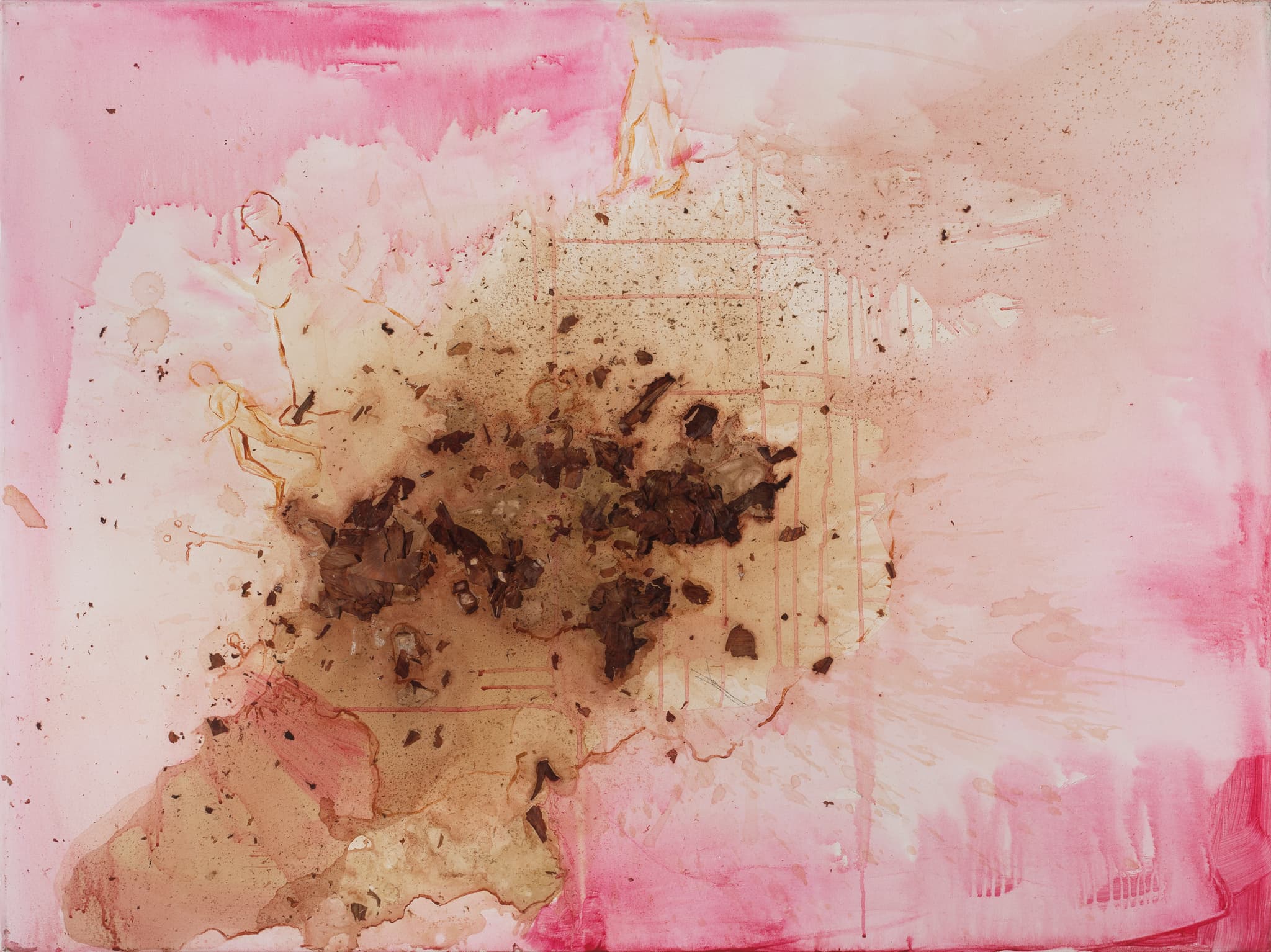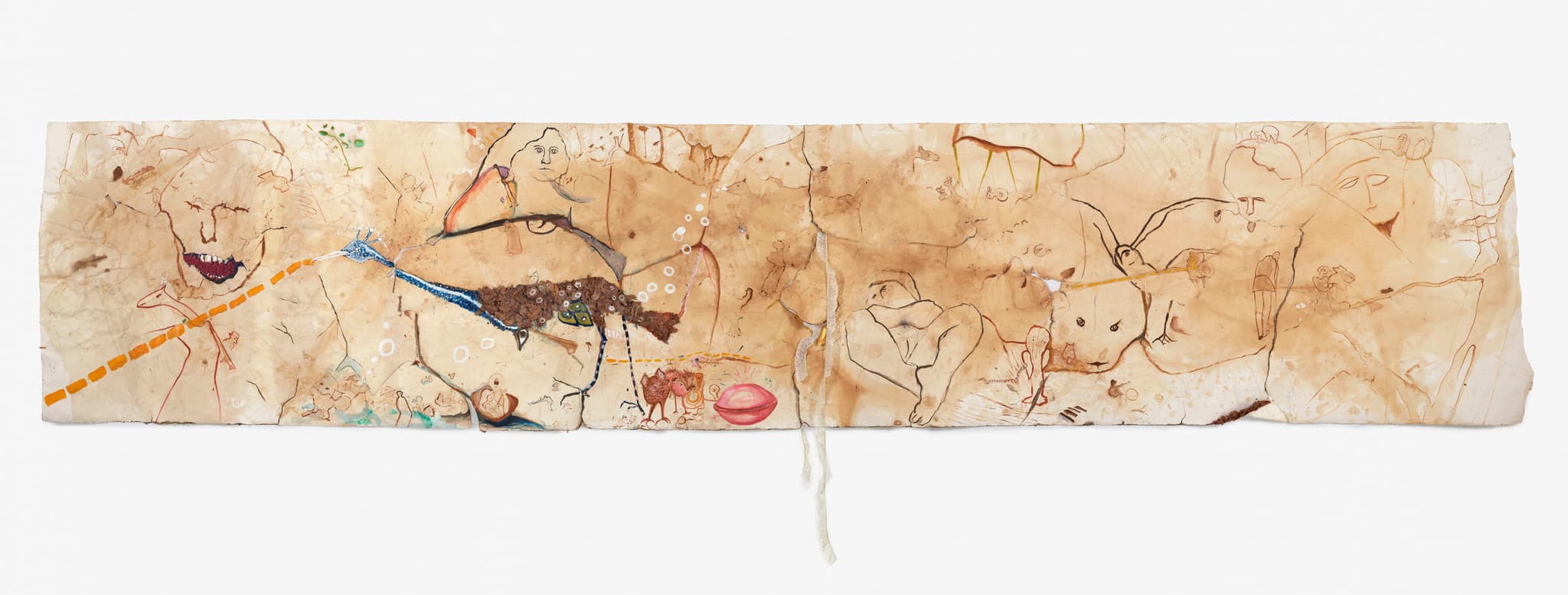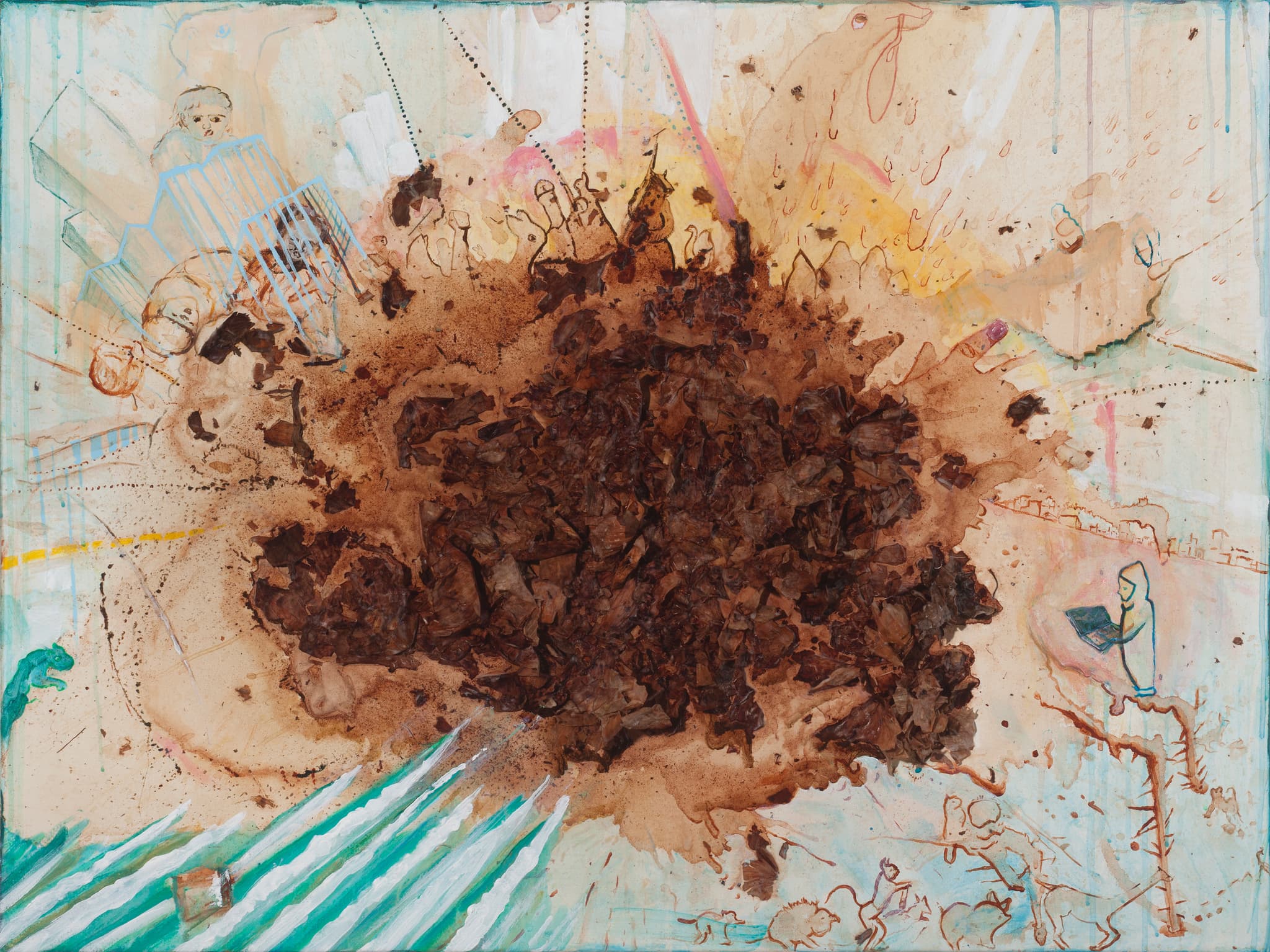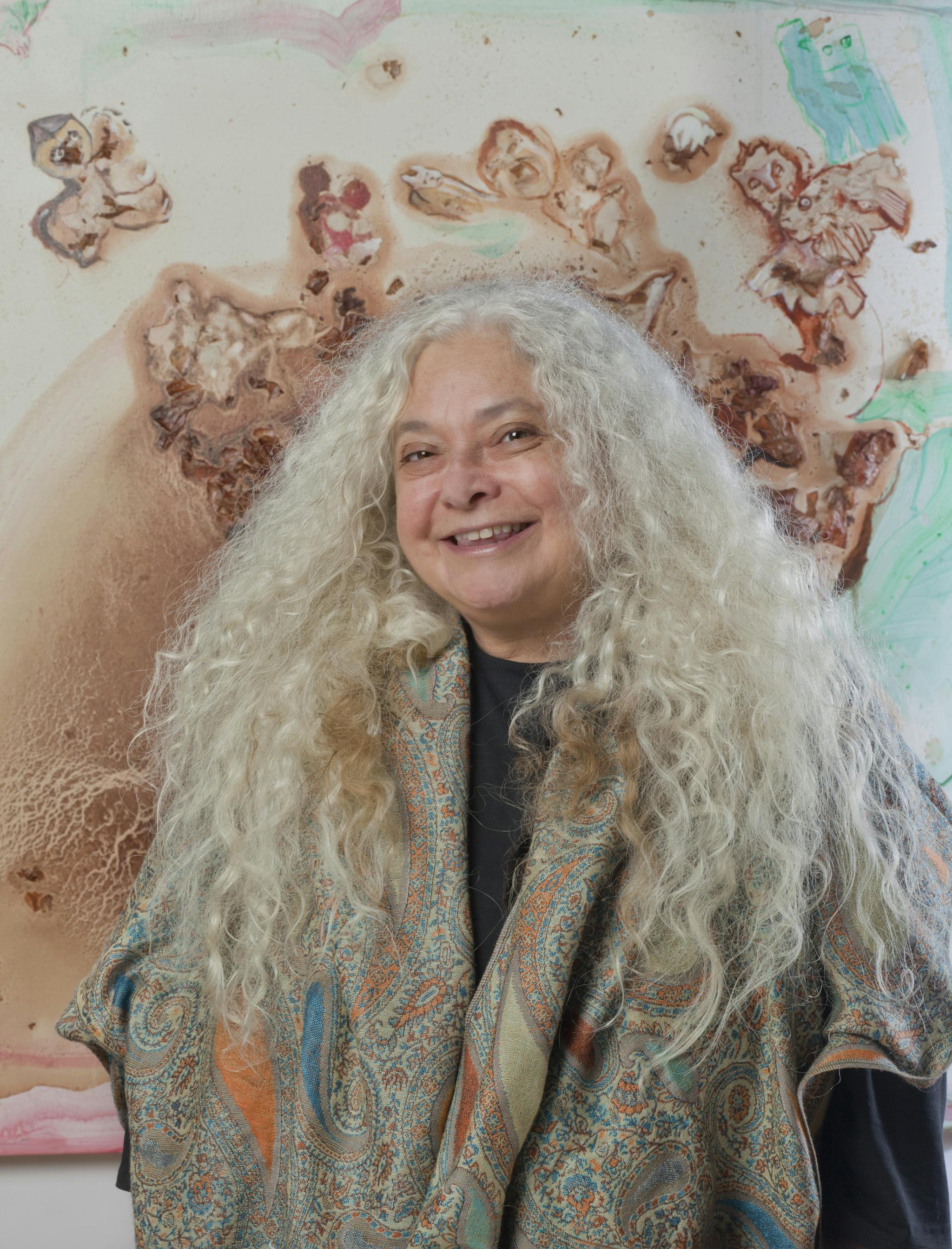When I first heard that Marsha Nouritza Odabashian was using onion skin dye in her work, I thought it was ingenious—but risky. Growing up, my Armenian American family dyed Easter eggs with yellow onion skins we culled from the bottom of our pantry and discretely harvested from the onion bins at Stop & Shop. My parents would place them in a pot of water with the eggs, add some vinegar, turn up the burner to boil, and voila: the eggs turned a deep crimson. In my experience, however, a pot sometimes failed to alchemize, and the eggs ended up looking more like your average everyday Grade A large brown eggs straight from the carton. What would Odabashian do in such circumstances?
I soon learned she would embrace the results. Though Odabashian’s initial work with onion skin dye in her 2015 series, “Expunge” features a range of deep brown and reddish hues, the more muted and natural brown tints of her 2018 exhibition, “Skins,” are fluid, evocative and deeply moving. Through the tea-like stains, it is clear that Odabashian is working with images from her family history, one similar to mine: our paternal grandmothers were survivors of the Armenian genocide of 1915, that tragic stain on history when roughly 1.5 million Armenians in the Ottoman Empire were forced from their homes and deported through the desert to their deaths. “Altamira,” a large drawing at 84” x 126,” suggests this history through illustrative images combined with figures of varying identifiability, sometimes appearing as fairy tale characters, other times like prehistoric wall paintings. The act of viewing echoes the subconscious-tapping practice of reading coffee cup grounds or trying to discern the shapes of cumulus clouds.
Odabashian’s recent solo exhibition at Galatea Fine Art, entitled “Stir: Drawings and Paintings from the Onion Pot,” and her “21′ Drawing,” part of the 26th iteration of the group drawing show curated by Chanel Thervil at the Mills Gallery at the Boston Center for the Arts, (Field Notes: Lovers, Teachers and the Consciousness In Between), pick up where she left off from “Skins.” The works at Galatea are contained in smaller canvases (under 48”), and this time, the onion skins themselves are the central focus, left on the canvas in all their organic shapes—in turn looking like insect shells or nests, like bird droppings or birds in flight. From the sculptural features, figures emerge on the stained field of the canvas. While progressing through the gallery and encountering these subtle forms—human beings, animals, and hybrid creatures; maps, buildings and cities; breasts and phalluses; foregrounds shifting to background—I felt I was navigating the multi-layered spaces of my own trauma.
I spoke to Odabashian at Galatea about the powerful ways she has embraced a medium—in all its unpredictable nuance—that gives her access to her own history, but also to the unknown, not to mention the most volatile events of our time.

Marsha Nouritza Odabashian, Data Collection, 2019. Onionskins, Onionskin Dye, Drawing Media and Acrylic Paint on Canvas, 36” x 48.” Photo by Will Howcroft.
Nancy Agabian: The most striking element of these paintings is your use of onion skin dye, which is traditionally used by Armenians and others to dye Easter eggs. Can you describe how you use it as a medium?
Marsha Nouritza Odabashian: I dye the canvas first: I take the canvas outside and I pour the pot of boiled onion skins on it and let it dry. After it’s dried, I might leave it outside for a while, sometimes days. I’ve left them out for a couple of weeks at a time. What results is a canvas layered with stains. Sometimes it’s very similar to watercolor process work-on technique where you put a wash on it and then another layer and you can keep building up layers, so there’s some transparency.
NA: So once you bring the canvas back inside the studio, how do you work from there to create the image of the whole painting?
MNO: Well, when it’s all dry, I lift the canvas or paper up. And some of the onion skins fall off, some of them don’t, and so I work with that. It is very much a conversation. The work is in control of me as much as I am in control of it. And so I look at the onion skin stains and the markings left behind, and then I start to imagine. Either events from history or something I heard on the news or almost anything, although they revolve around certain themes, such as displacement, genocide, creativity.
NA: I think of these as paintings, but you also refer to them as drawings. Why?
MNO: Well, they are on the border between drawing and painting. I use line which tends to evoke drawing, but I also combine the dye with paint. And I think the ones that are on paper seem more like drawings. “21’ Drawing” [at Boston Center for the Arts] leans more toward drawing, because it’s executed on paper instead of stretched canvas and the figures are created with a greater emphasis on line. But then when you see it, there are some areas that are very painterly.
Like the drips. They’re watery, they’re a little dreamy, a little more emotional. Metaphorically they can be about rain or a cloudy day. So what I was interested in, especially with this one, “Data Collection” (2019), is forming a grid. Because we think of data as lines and columns. I lifted the canvas so that it made vertical drips and horizontal drips. So I’m always teetering between deliberate and not deliberate. And chance and control.

Marsha Nouritza Odabashian, 21’ Drawing, 2019. Onionskins, Onionskin dye, Graphite, Colored Pencils, Conte Crayon, Acrylic Found Paper, Lace on Arches Watercolor Paper, Approximately 67”x 252” (45”x 252” without lace). Image courtesy of the artist.
NA: There’s an element of mystery at play in these works. Where does that come from?
MNO: It’s about listening, hearing, responding, learning from something outside of myself and maybe even some other higher spiritual being or power that’s telling me, “Do this,” because sometimes I just feel it’s coming from somewhere else. It’s not that I have no control, but it’s a cooperative way of being with the artwork.
It’s also about hierarchy. I have this very cooperative way of wanting to work and to be. From my Armenian upbringing, I know the way that my grandparents had to be careful about everything they did. As second class citizens in the Ottoman Empire there were very strict authorities mandating what they could and couldn’t do. So as a painter I want to undo this kind of hierarchical arrangement.
NA: I imagine as immigrants to the U.S. they also had to adhere to rules for fitting in and assimilating. We all have these voices in our heads, to varying degrees, to be a certain way or to behave. You’re embracing what’s happening on the page because it’s not “perfect.”
MNO: Absolutely. For me, imagination and creativity are so fundamental. I think of Paul Klee putting his paper down on a marble tabletop and then tracing it or making figures, finding the image in that, and then developing it in a creative, imaginative way. And the Surrealists did the same thing. I’m interested in how two different things can occupy the same space, sort of like Magritte: a leaf can be a leaf, but it can also be an animal or a bird or something. And so if I find something that appears as two different things, I embrace it. Which is probably why I like the format of a central image: something that you see from far away that makes you want to look closer, and then you discover smaller images are scattered throughout.
NA: There are multiple layers. And a lot of feelings. The onion skin especially is very emotive. What is your relationship to this work emotionally?
MNO: It varies completely, because I’m kind of channeling—if that’s the right word—everything, going back to before I was born and my grandparents and the genocide. And reflecting on my life, being successful at certain things. And all that brings up a range of feelings. There’s my personal history but also ancestral history, which strongly forms my view of the world. I also study Armenian art and art history: I recently traveled to Eastern Anatolia, what’s also known as Western Armenia or historical Armenia [and currently Turkey.] I’m interested in preservation and art forms that aren’t part of the mainstream. So I’ve looked at Armenian medieval manuscripts and the architecture.

Marsha Nouritza Odabashian, Empire, 2019. Onionskins, Onionskin Dye, Drawing Media and Acrylic Paint on Canvas, 36” x 48.” Photo by Will Howcroft.
NA: Sometimes I see buildings or cities or architectural elements in the work. Is that interest where some of those features come from?
MNO: Absolutely. The trip I made was an academic tour with Christina Maranci [Professor of Armenian Art and Architecture at Tufts University]. We went to [historically Armenian sites of] Akhtamar and Van, and a lot of what we were looking for were signs of Armenian culture, whether a cross or a symbol carved into a ruin. Where did that come from? Locally they’re not really known as Armenian, because the history has been denied and repressed. So there are these hidden images, in plain sight, that are in the landscape or in buildings.
The other thing about the onion skins is that they remind me of landscape. Especially when you’re in that part of the world where it’s dry, and it’s just a fantastic landscape with incredible mountains and land formations—and it’s so beautiful. And yet there was all this bloodshed and destruction. I’m interested in that juxtaposition of ideas and images. My last show at the Armenian Museum was called “Skins,” and it’s been written that the paper looked like skin. But also, the color of skin and the color of the landscape are very similar, but also diverse. They connect to my themes of power and control, oppression and freedom, migration and home rooted in genocide and a colonial past. I often determine the color or tone of a character by the landscape it inhabits, fusing it with the landscape to remain hidden or invisible.
Another theme that I use often is a procession and you see it here in “Empire.” In this piece, you see people arranged like the Sumerian creatures—the animals on the bullheaded lyre from Mesopotamia. It has these registers of different animals doing various things but in their own procession.
NA: What does the procession mean for you?
MNO: It first came about because I was doing a lot more work on genocide in time and its people in transit, moving, being forced to leave, or leaving on their own—departing. And it happens over and over again, as it’s happening now in Syria, and at the [U.S.] border [with Mexico]: history repeats itself.
On the bullheaded lyre the creatures are in procession as if they’re in a banquet and they’re serving royalty. I’m always exploring the relationship between humans and animals and especially how in mythology people would turn into animals, or have proximity to animals or the way they used animals. This camel/horse figure [she points to a figure in Rideshare] is going into outer space with these ride sharers. Are they riding the animal, or is the animal accompanying them? I want my works to be about asking questions as much as they mirror reality or make a statement.
NA: It’s interesting that this issue of the nature of animals and humans—and their inter-connectivity—has emerged from the use of a natural material, one that is physically, literally layered. Do you think you’ll keep working with it?
MNO: I have a lot of onion skins saved now because I developed a rapport with somebody at Whole Foods, and I got a whole box of them! [She laughs.] So I have no choice. Well I do, but I enjoy using the onion skins. It’s taking me places and I don’t know where it will go. People have asked me if I’ve used other kinds of natural dyes and I’m interested in doing this, too. But I feel that I’m exploring so much right now—from something that has been discarded.

Marsha Nouritza Odabashian, Stir: Drawings and Paintings from the Onion Pot, installation view, Galatea Fine Art, 2019. Image courtesy of the artist.
After our interview wrapped up, Marsha mentioned that her work with onion skins linked what has been considered women’s work with her conventional Western art school training. This is underscored in her 21′ Drawing. On the paper, figures cavort and merge with the background, and small creatures weave in and out of their sprawling shapes; actual lace emerges from the paper and trails down the wall, a different kind of border—gauzy and dreamlike—than the bright yellow and blue dotted lines that separate a dancing giraffe’s head from her body, that form a peacock’s leg, or connect shapes that look like genitalia. Maps inside our bodies, the work suggests, are held by women and our female ancestors—and accessed through their rituals. Marsha Nouritza Odabashian’s 21’ Drawing is on view as part of The 26th Drawing Show Field Notes: Lovers, Teachers and the Consciousness In Between curated by Chanel Thervil at the Boston Center for the Arts Mills Gallery until December 22, 2019.

Marsha Nouritza Odabashian, 21’ Drawing, 2019. Detail view (middle). Image courtesy of the artist.






